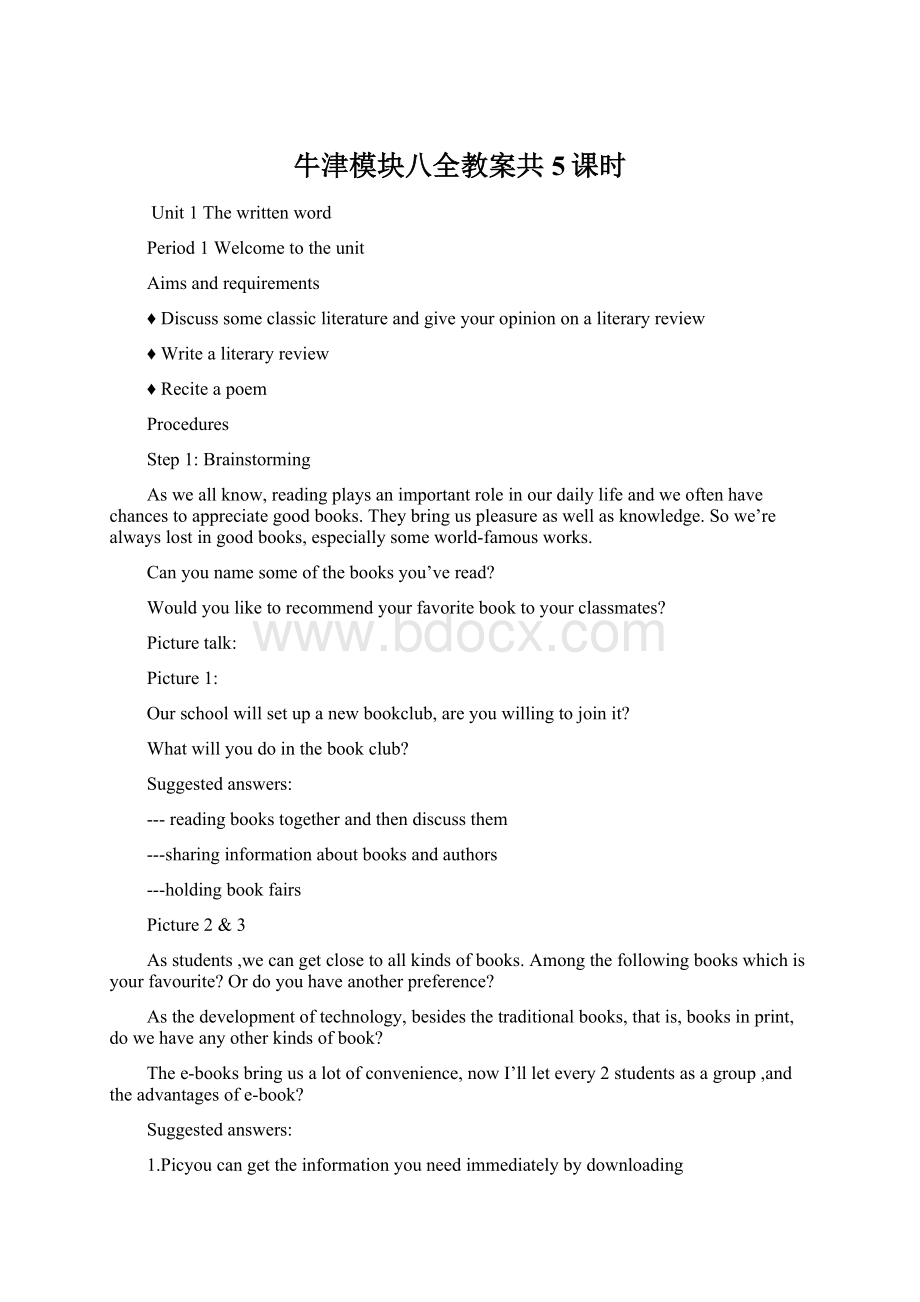牛津模块八全教案共5课时Word文档格式.docx
《牛津模块八全教案共5课时Word文档格式.docx》由会员分享,可在线阅读,更多相关《牛津模块八全教案共5课时Word文档格式.docx(53页珍藏版)》请在冰豆网上搜索。

---holdingbookfairs
Picture2&
3
Asstudents,wecangetclosetoallkindsofbooks.Amongthefollowingbookswhichisyourfavourite?
Ordoyouhaveanotherpreference?
Asthedevelopmentoftechnology,besidesthetraditionalbooks,thatis,booksinprint,dowehaveanyotherkindsofbook?
Thee-booksbringusalotofconvenience,nowI’llletevery2studentsasagroup,andtheadvantagesofe-book?
1.Picyoucangettheinformationyouneedimmediatelybydownloading
2.E-Booksarecheaperthanpaperbooks.
3.E-bookstakeuplessspace.
4.E-booksareportableandsoyoucancarryitwhereveryougo.
Also,Ihaveaafter-classthinking,thatis----thedisadvantagesofe-books.
Step3:
Homework
1.Introduceabooktoyourfriend.Trytopresentitfullytohim/her.
2.PreviewReading.
Period2—3Reading
Step1:
Lead-in
1)Movie-appreciation:
Doyouknowsomethingaboutthefilm?
ThestoryisbasedonDickens’sfamousnovel“OliverTwist”.It’sanexampleofclassics.Classicsaretheantiquesoftheliteraryworld.
Inthisunit,we’llhavethechancetogetmoreinformationaboutclassicliterature.
2)Backgroundinformation:
CharlesDickenswasbornon7February1812inPortsmouth,England.HehadahappychildhoodafterhisfamilymovedtoChatham.Attheageof12,Dickenshadtoleaveschoolbecausehisfatherwasimprisonedfordebt.ThepovertyandadversityDickensexperiencedasachildgreatlyinfluencedhislaterviewsonsocialreform.Beforehisdeathon9June1870,hewroteabout15majornovelsandmanyshortstories,mostofwhicharefamousfortheirsurprisingendings.
Step2:
pre-readingactivities
PayattentiontotheReadingstrategyofthearticle,focusingonthewaytheauthortriestoconvincethereadertoadoptacertainpointofview.Pointouttheseplacesintheessay:
1.Toreconsiderourideasaboutclassicliterature.
2.Topayattentiontotheinformationthatmakesusinterestedbutnotenoughtogiveawaythestory.
Fastreading
1)Withthereadingstrategyabove,let’sdoourReading.ReaditquicklyandtrytograspthemainideaofthetextandfinishPartAonPage2
GothroughthepassageasquicklyaspossibleandtrytofindanswerstothethreequestionsinpartAonPage2.
Suggestedanswers
A1Classicsaretheantiquesoftheliteraryworldincludingnovels,playsandpoemsthatwerewrittenalongtimeagoandwerewellwrittenandreceived.
2England’sgreatestwriter.
3Sevenyearsold.
Step4:
Detailedreading
1)SecondreadingtocompletePartsC1,C2andD
Suggestedanswers
C11Becausetheythinktheyareold-fashionedandboring,andhavenothingtodowithlifetoday.
2Shedoesn’tthinkthattheyareold-fashionedorboring.
3Joeisakindandsimpleman.
4Onhisgravestoneitreads,‘Byhisdeath,oneofEngland’sgreatestwritersislosttotheworld.’
5Astranger.
6BecausehethinksJoeisnotcleverenoughandfarfrombeingawelleducatedgentleman.
7Helearnsthatwealthdoesnotbuyhappinessandthatfriendsaremoreimportantthanafancyeducation.
8AnexampleofcharacterdevelopmentisthechangeinPipfrombeingconcernedonlywithmoneytoseeingthatmoneyisnotthemostimportantthinginlife.
Step5Languagepoints
1)Usefulexpressions
havesomethingtodowith,haveaplace,intheworld,bebasedon,bemadeinto,atatime,onstage,besetin,haveakindwordtosb.,asymbolof,setsb.free,beforelong,bekindto,intheearly1800s,bebenton
2)Sentencestuctures:
1.Theyarenovels,playsandpoemsthatwerewrittenalongtimeagoandweresowellwrittenandwellreceivedthatpeoplestillreadthemtoday.
2.ButJoeisakindandsimpleman,whowouldratherdiethanseeanyharmcometoPip.
3.ExcitedbyhismovetoLondon,Pipcanhardlywaittobeginhisnewlife.
Step6Homework
1.ReadthereviewofthefamousnovelLesMiserablesinpartBonpage105oftheWorkbook.
2.AccordingtowhatwelearnthisclassandHomework1,writeareviewaboutoneofyourfavouritemovies.
3.Previewwordpower
Period4—5Grammar
Teachingaims:
Teachthestudentsknowleageaboutnegativestate
Lead-in:
OnepictureofBeijingUniversity:
BeijingUniversityisnotoneofthebestuniversitiesinChina.-----Negativestatements
self-thinking
Themostcommonlyusednegativewordsare:
no,not,neverandneither
Step3&
4:
Concludetheform(s)ofnegativestatement
Fillin4tablesabouttheexamples,types,structures,conclusionsofnegativestatements.
Part1.
Examples
Structures
Types
conclusions
1.Idonot
thinkso.
2.Ihaveneverseenthefilm.
3.Idonotlikeeitherofthefilms.
4.Theproblemsremainedunsettled.
1).助动词+not
2).全否定词+肯定谓语部分
3).not+any/anyone/anybody/anything/
anywhere/either
4).
带否定词缀的词
全体否定
全体否定是百分之百地否认一个事物的存在、成立或真实性。
表示全体否定的否定词有:
no,not,nothing,
nobody,none,
nowhere,never,neither,nor,not...nearly,not...half,以及not...possible等.
Part2
1.Itisnotuncommontofindherreadingthenewspaper.
2.Unlessyoureadthenovelyourself,youwillneverknowwhathappensattheend.
1)把否定词not放在带有否定前缀的单词前面:
这类双重否定形式,是一种委婉说法,削弱了句子意义,语气通常比单纯的肯定句弱。
2)用否定跟含否定意义的连接unless,until,but等词连用,构成双重否定,用来表示强烈的肯定
双重否定
双重否定是指两个否定成分限定同一个词或词素;
或是一个否定词否定另一个否定词,取得肯定意义的表达形式。
否定之否定成为肯定,这是合乎逻辑的。
Part3
1.Notmanypeopleheardthespeech
=Veryfewpeopleheardthespeech.
2.Notallhesaidwastothepoint.
3.Ican’tseeeverybody.
4.Idon’twhollyagreewithyou.
1.not+many/much/verymuch/some/aphraseoftime,distanceoranounphraseincludingquantities.
2.not+all/both/each/everybody/everything
3.以一般否定句的形式出现,即把否定主语的not与谓语动词放在一起。
部分否定
含有总括含义的词,用于否定句时,只否定一部分,而不是完全否定.如all,everybodyeverything,always,both,wholly等词与not连用时,在汉语中译为
“不全是”
“不总是”等.
Part4
1.Iwonderwhether/ifIshouldn’tbringanumbrella.
=Iwonderwhether/ifIshouldbringanumbrella.
2.Iwouldn’tbesurprisediftheydidn’tmovesoon.
=.Iwouldn’tbesurprisediftheymovedsoon
主句+whether/if引导的否定陈述
if从句中的附加否定
将否定词和whether
/if连用,来表达对于某种情况的疑虑,常用于口语中.
Iwonderwhether/if…
一般用于表达个人的决定
Iwouldn’tbesurprisedif…
一般不用于表达个人的决定
Part5
1.Pipcanhardlywaittobeginhisnewlife.
2.Theclassisarefarfromdisappearing.
3.Pip’ssisterseldomhasakindwordtosay
4..Unlessyoureadthenovelyourself,youwillneverknowwhathappensattheend.
5.Thefortunesetshimfreefromfinancialworries.
6.Joewouldratherdiethanseeanyharmcome
topip.
隐性否定是一种有意无形的含蓄否定,常用含否定词的单词,词组,句型等来表示否定意义.这种否定意义用法隐藏在句子的深层含义中.
隐性否定
含有否定意义的词汇与结构
1.动词及短语动词:
fail(+todo.),miss,ignore
prevent/keep/protect...from等2.名词:
absence,failure,refusal等
3.形容词:
few,little,free(from),farfrom等
4.副词:
hardly,seldom等
5.介词:
above,beneath,below,out(of)等
6.连词:
unless,before,or等
7.结构:
too…to太…(以致于)不
rather…than“宁愿…而不”等
Step5
DoPartAonpage9
Step6
FinishPartBonpage9
Step7.Homework:
DoPartC1andC2onpage102oftheworkbook
Period6Task
Todevelopstudents’sablityoflistening.
Toteachthemhowtowriteliteraturyreview.
Skillsbuilding1:
listeningforkeywords
ReadtheguidelinesinSkillsbuilding1onPage10.Trytogiveaspeech,followingtheguidelines.
Step1:
recognizingkeywords
1.Listentothisspeech,tryingtofillthetableinPartAonPage10.
2.Listentothetapeagain,andchecktheanswers.
3.Whatroledoyouthinkfriendshipplaysinourdailylife?
Now,let’sreadashortstory.Afterthat,youmaygetabetterunderstandingoffriendship.
4.Readthestoryagainandthencompletethetablewiththekeywordsintheshortstory.
5.ListentotheconversationinPartCandcheckyournotesinPartBagainstwhatyouhearinPartC.
Skillsbuilding2:
askingforandgivingopinions
1.Groupwork:
Discussion:
Howtoaskforandgiveopinions?
2.Pairwork:
Createasituationandmakeadialogue,you’llpracticeusingthephrasesyoulistedjustnow.
3.ReadtheguidelinesonPage12.
givingyouropiniononaliteraryreview
1.Readtheliteraryreviewof“TheAttic”onpage12.Focusontheplot,charactersandthethemeofthestory.
2.Haveadiscussionaboutthefivequestionslistedbelowthereview.Giveyourideasfreely.
3.Acting:
Workinpairs,makingadialogue.Oneactsasthereporterandtheotherasthereader.Trytouseasmanyquestionsaspossible.
Sampleanswers
Reporter:
Goodmorning,MissYang.I’vejustreadyourliteraryreviewof‘TheAttic’inamagazine.CouldIaskyouafewquestionsaboutit?
Reader:
Sure.Whatwouldyouliketoknowabout?
Doyouthinktheplotof‘TheAttic’soundsinteresting?
Yes,itisreallyentertainin